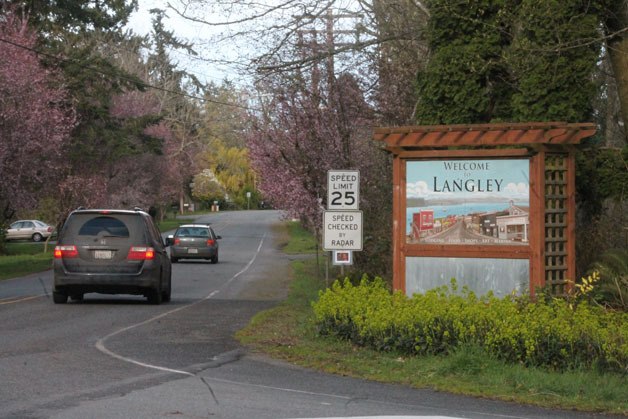Langley, a city without a single signal light, is thinking about putting in a couple more stop signs at one of its gateways.
Prompted by residents’ requests, the city council discussed installing two stop signs on Brooks Hill Road/Third Street, at the intersection with Coles Road. Doing so would help control traffic entering and exiting town, Mayor Tim Callison said.
Currently, the county right of way of Brooks Hill Road is a 40 mph zone. Its speed limit is consistent from near Bayview Corner all the way to the city limits at Coles Road, which is also a 40 mph street. In Langley proper, the speed limit is 25 mph, but the mayor and others at Monday’s city council meeting said people often drive much faster near the gateways, especially at Coles Road.
“That Coles/Brooks Hill Road intersection, when you’re turning … onto Brooks Hill Road, is pretty dangerous because the road curves away from you,” Callison said in an interview prior to the council meeting.
“They see, often times, people going much faster, speeding up once they get past St. Hubert,” he added, referring to the southwest-bound traffic leaving Langley.
Families with young children are moving into that area of town, he said. They want to make sure their children can safely walk the streets. Victoria Locke Carty, a resident of the city, said she saw an elderly woman crossing the street just prior to the council meeting and two cars had to stop for her because there wasn’t a stop sign or crosswalk.
“Something is going to happen if measures aren’t taken,” Locke Carty said.
More than a decade ago, but still fresh in the minds of the council, two teenagers died in a one-car crash in that very area. Jayson Jelinek, 18, and Kelly Frantz, 17, died after Jelinek’s 1985 Honda Accord struck two trees on Third Street. A Washington State Patrol trooper at the time reported the car traveling at an estimated 70 mph, and impairment was believed to also be a factor. Councilman Bruce Allen said that fatal crash was unrelated to any traffic control mitigation, but as soon as conversation began about the addition of stop signs in that area, several council members discussed it. 
Until a recent wind storm destroyed it, a bench stood in Jelinek’s and Frantz’s memory at the very spot where the car crashed, near the intersection some Langley residents claim is a hotspot for speed limit violations.
Police Chief Dave Marks said there were 13 crashes with injuries since 2002, plus another 19 non-injury accidents between 1999 and 2013. He said he can wait in that area for hours and not cite anyone because traffic can see him coming from just about any direction if he parks along the roadside. But issuing tickets and fines wasn’t the point. Police presence and a not-so-subtle reminder of the speed limit, however, were his reasons.
The stop signs would slow traffic through two functions. The first, and most obvious reason, is that it forces traffic to stop, thus limiting the distance a vehicle can travel at a high rate of speed. Callison said the other important function is the caution sign for both northbound and southbound traffic, prior to the stop, that informs drivers to begin slowing down.
Talk of new traffic control measures can often draw people’s ire because they are used to the existing traffic flow, for better or worse. Callison said he expected this idea, still being considered and not yet approved, to face similar criticism, though more from outsiders than the residents to whom he is beholden.
“The people that fly through there on their way to someplace else probably won’t be too happy,” he said.
Before the city can install them, traffic studies about volume, collision incidents and speed tracking are necessary, city public works director Stan Berryman said. Some people asked him about speed humps, traffic control measures that more gradual and less intrusive than traditional speed bumps. In his previous position in Colorado, Berryman said they were not effective and people would use bolt cutters to remove the rubber mounds.
“They don’t physically work,” Berryman said.
Not all were on board with the stop sign idea. Frank Ploof, a city resident, said there are plenty of signs in town.
“And they don’t work,” Ploof said.
In that area alone there are 25 mph speed limit signs on the way into and out of town, an electronic radar sign on the way into Langley, city-posted children playing signs, and even one sandwich board-style sign popped up near Minnie Lane that reads “Drive like your children play here.”
The council directed Callison and the city staff to research the different options and costs and report to them at a future council meeting.


